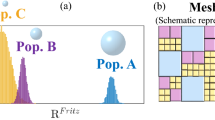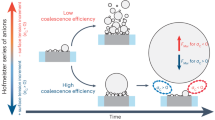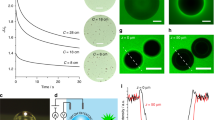Abstract
It is shown how the various components of the overpotential due to an attached bubble on an electrode can be separated and estimated. By considering the resistance increments due to the presence on the electrode surface of a bubble, obtained from impedance measurements, it is possible to determine the predominant potential distribution which controls the gas evolution. A relationship between the measured overpotential and the diameter of the bubble is established. The time evolution of the overpotential due to a growing bubble is modelled in the case of the limitation of the bubble growth by dissolved gas diffusion in the solution. In agreement with previous experimental results a linear time variation is found.
Similar content being viewed by others
Abbreviations
- b b,b f :
-
Tafel coefficients (V−1) Equation A7
- δc :
-
difference between the supersaturation and saturation concentrations (mol m−3)
- C :
-
electrode double layer capacity (F)
- C 0 :
-
electrode double layer capacity per surface unit (F m−2)
- C A,C B :
-
concentrations of species A and B in the redox system (mol m−3)
- d b :
-
diameter of a bubble or a sphere on the electrode (m)
- d e :
-
diameter of the disc electrode (m)
- D :
-
diffusion coefficient of the dissolved gas (m2 s−1)
- E :
-
electrode potential (V)
- E z :
-
zero-charge potential of the electrode (V)
- F :
-
Faraday constant, =96487 C mol−1
- I :
-
electrolysis current (A)
- I F :
-
faradaic current (A)
- k b,k f :
-
heterogeneous rate constants of the redox reaction (m s−1)
- k 1 :
-
slope of ΔV/t curve (V s−1), Equation 5
- k 2 :
-
slope of ΔV/t 2/3 curve (V s−2/3), Equation 5
- K :
-
Henry coefficient, Equation 1
- n :
-
number of the electrons involved in the reaction to form one molecule of the dissolved gas
- Q :
-
electrical charge of the electrode double layer (C)
- r b :
-
radius of a bubble or of a sphere on the electrode (m)
- R e :
-
electrolyte resistance (Ω)
- R e0 :
-
electrolyte resistance for an electrode of 1 m in diameter (Ωm), Equation 32
- R p :
-
polarization resistance (Ω)
- R p0 :
-
polarization resistance per surface unit (Ω m−2)
- R t :
-
charge-transfer resistance (Ω)
- s :
-
relative rate of variation of the electrode active surface due to a growing bubble (s−1)
- S :
-
disk electrode surface (m2)
- ΔS e, ΔS p :
-
equivalent screened surfaces by a bubble or a sphere given byR e andR p changes (m2), Equations 18 and 29
- t :
-
time (s)
- V :
-
potential difference between the working and the reference electrodes (V)
- V 0 :
-
gas molar volume: 24.5×10−3 m3 at 298 K
- ΔV :
-
total overpotential increment due to a bubble or a sphere (V)
- ΔV a, ΔV ohm :
-
activation and ohmic overpotential increments due to a bubble or a sphere (V)
- α:
-
slope of log ΔV/logI curve, Equation 11
- αe, αp :
-
dimensionless parameters in Equations 27 and 30
- β:
-
dimensionless coefficient in Scriven law, Equation 2
- η t :
-
total overpotential (V)
- η a,η c,η ohm :
-
spatial averages of the activation, concentration and ohmic overpotentials over the electrode surface (V)
- ϱ:
-
electrolyte density (kg m−3)
- i:
-
in the absence of the growing bubble
References
S. Shibata,Electrochim. Acta 23 (1978) 619.
S. Shibata,Bull. Chem. Soc. Japan 33 (1960) 1635.
H. Vogt,Electrochim. Acta 29 (1984) 167.
H. Vogt,Electrochim. Acta 25, (1980) 527.
Lord Rayleigh,Phil. Mag. 34 (1917) 94.
D. E. Westerheide and J. W. Westwater,AIChE J. 7 (1961) 357.
N. P. Brandon and G. H. Kelsall,J. Appl. Electrochem. 15 (1985) 475.
L. E. Scriven,Chem. Eng. Sci. 10 (1959) 1.
S. Van Stralen, R. De Jonge and H. Verhaart, in ‘Boiling Phenomena,’ Vol. 1 (edited by S. Van Stralen and R. Cole), McGraw Hill, New York (1979) Ch. VI.
R. Darby and M. Haque,Chem. Eng. Sci. 28 (1973) 1129.
K. J. Vetter, ‘Electrochemical Kinetics, Theoretical and Experimental aspects’ (edited by S. Brückenstein and B. Howard), Academic Press, New York (1967).
J. A. Leistra and P. J. Sides,J. Electrochem. Soc. 134 (1987) 2442.
J. Dukovic and C. W. Tobias,J. Electrochem. Soc. 134 (1987) 331.
C. Gabrielli, F. Huet, M. Keddam and A. Sahar,J. Appl. Electrochem 19 (1989) 683.
C. Gabrielli, F. Huet, M. Keddam,J. Appl. Electrochem. 15 (1985) 503.
C. Gabrielli, F. Huet, M. Keddam and J. F. Lizee,J. Electroanal. Chem. 138 (1982) 201.
J. P. Glas and J. W. Westwater,Int. J. Heat Mass Transfer 7 (1964) 1427.
J. J. Miksis and J. Newman,J. Electrochem. Soc. 123 (1976) 1030.
P. J. Sides and C. W. Tobias,J. Electrochem. Soc. 127 (1980) 288.
A. Sahar, PhD Thesis, Université de Paris IV (1988).
C. Gabrielli, F. Huet, M. Keddam and A. Macias, to be published.
Author information
Authors and Affiliations
Rights and permissions
About this article
Cite this article
Gabrielli, C., Huet, F., Keddam, M. et al. Potential drops due to an attached bubble on a gas-evolving electrode. J Appl Electrochem 19, 617–629 (1989). https://doi.org/10.1007/BF01320636
Received:
Revised:
Issue Date:
DOI: https://doi.org/10.1007/BF01320636




